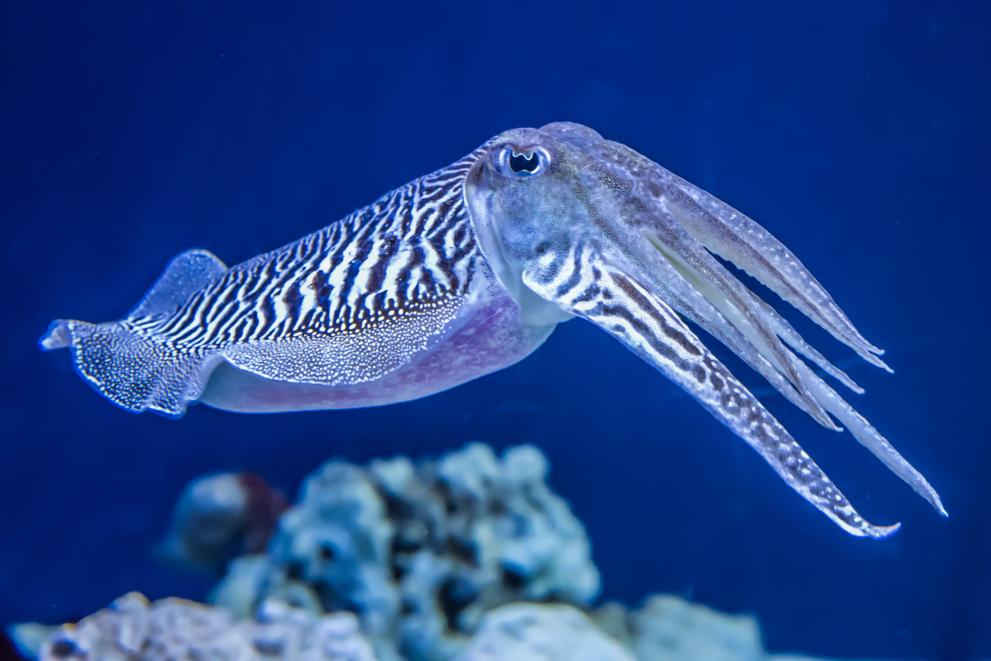
Marine renewable-energy devices, such as wind turbines and wave or tidal energy systems, have proliferated in the last ten years. However, their installation produces loud noises and vibration which can cause environmental disruption. Whilst these sounds have been shown to impact fish and marine mammals1, there has been little investigation into their effects on invertebrates living on, or near, the seabed.
The European common cuttlefish (Sepia officinalis) is a cephalopod invertebrate (a class of marine molluscs) usually found swimming near, or resting on, the seabed. The species is present in the Mediterranean, North and Baltic Seas, and provides one of the most valuable fisheries in the English Channel. This study conducted laboratory ‘controlled exposure experiments’ on cuttlefish, captured from a bay in north western France, to investigate potential impacts of wind farm installation noise.
The researchers ran experiments on eggs, larvae and adult cuttlefish and kept them in laboratory seawater tanks. They exposed separate test groups from each life stage to both drilling and pile-driving noise in the tanks at three intensity levels, played through an underwater speaker. They also maintained control groups in the same conditions without noise exposure. The researchers observed the effects on egg hatching success, larval survival, adult behaviour and sensory tissues of both larvae and adults (determined by scanning electron microscopy analysis of cell damage).
The researchers report significant negative effects on many of the study groups. Hatching success of eggs was lower under medium and high intensity sounds from both drilling and pile driving, they say, falling to 9% in the case of high intensity pile-driving noise – compared to 72% for the control group. Larval survival was impacted by high-intensity sounds from both sources (170 dB re 1 μPa2 and 167 dB re 1 μPa2, respectively), reaching 10% in one set of tests for pile-driving noise – compared with 100% survival for controls. Sound pressure levels lower than 163 dB re 1 μPa2 were not found to elicit severe damage.
Damage to cells in the statocyst (a balance organ located inside the head) was found to be significant 48 hours after exposure in all tests of larvae and adults. The level of damage increased with noise intensity, affecting 47.4% of cells in the case of larvae exposed to high intensity pile-driving noise. However, the behaviour of adult cuttlefish was not affected by any noise exposure, according to the researchers. The effects presented above can be considered acute only in the very vicinity of the sound source where they have the potential to affect cephalopod populations and their offspring.
Based on these results and some assumptions about real-world conditions, the researchers estimate that larvae and adults may be severely impacted in the immediate vicinity of drilling noise or within 100–300 metres of pile-driving noise, while eggs might be affected within a range of around 500 metres from pile driving. They argue that the lack of behavioural response suggests that animals would not move away from the noise even if it were harming them. They note that this study only considers single exposures, and that the combined effects of multiple exposures over extended periods require further research.
These results are important for evaluating the potential environmental impacts of marine renewable-energy system installation and making informed mitigation decisions, say the researchers. They suggest that further studies are needed to assess the impact of such activities on wild cuttlefish populations. They also highlight the need to conduct further research into effects of noise disturbance on bottom-dwelling and immobile species found in the vicinity of such facilities.
It is important to note that the offshore renewable industry has already put in place solutions to reduce noise during construction. Among the various solutions proposed, the air-bubble curtain is often applied due to its efficacy in noise reduction. In addition, the threshold values for descriptor 11 (Energy incl. Underwater Noise) under the Marine Strategy Framework Directive will apply to all sectors, including the offshore renewable industry.
Footnotes:
- See: Tougaard, T., Carstensen, J., Teilmann, J., Skov, H., Rasmussen, P. (2009) Pile driving zone of responsiveness extends beyond 20 km for harbor porpoises (Phocoena phocoena (L.)). J. Acoust. Soc. Am. 126: 11–14.
Source:
Solé, M., De Vreese, S., Fortuño, J.-M., van der Schaar, M., Sánchez, A. M. and André, M. (2022) Commercial cuttlefish exposed to noise from offshore windmill construction show short-range acoustic trauma. Environmental Pollution 312: 119853. Available from: https://doi.org/10.1016/j.envpol.2022.119853.
To cite this article/service:
“Science for Environment Policy”: European Commission DG Environment News Alert Service, edited by the Science Communication Unit, The University of the West of England, Bristol.
Notes on content:
The contents and views included in Science for Environment Policy are based on independent, peer reviewed research and do not necessarily reflect the position of the European Commission. Please note that this article is a summary of only one study. Other studies may come to other conclusions.
Details
- Publication date
- 8 March 2023
- Author
- Directorate-General for Environment

